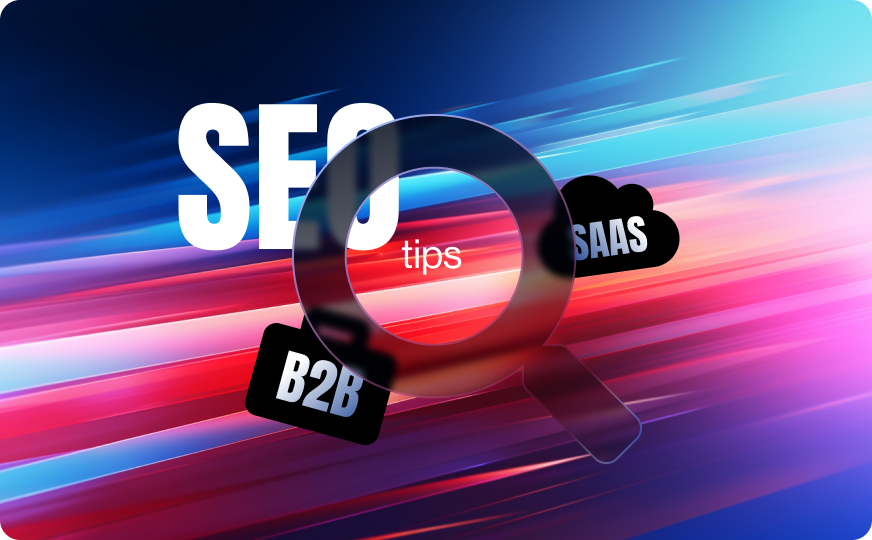B2B & SaaS SEO: Expert Tips and Best Practices
Ever feel like your website gets washed away by Google’s algorithms?
Let’s change that. In this article, we’ll be sharing the best SEO practices for B2B & SaaS companies. Whether you’re a seasoned pro or just starting out, our tactics and tips will bring your business out of the shadow on Google. The B2B landscape gets fiercely competitive, but these few SEO principles will help you improve your search engine rankings without any guesswork.
Understanding B2B & SaaS Audiences
Let’s settle this first: there’s a whale of a difference between SEO for B2B and SEO for B2C. With B2C, your audience is just that: your consumer. However, B2B SEO targets multiple people at once: an entire team of decision-makers within a company. To secure a sale, your B2B SEO will have to engage multiple personas and roles.
Buyer personas for B2B and SaaS businesses usually include specific information about a person, such as their age, education, where they work, what they do, and who they report to. The ideal buyer persona profile should also include the person’s pain points or major challenges.
According to BetterCloud, SaaS applications make up 70% of total company software use. For SaaS marketers, this implies two things:
The SaaS market growth is awfully fast.
The target audience for this type of marketing is narrow – you need to target a certain type of industry, and company size and need.
A limited quantity of customers and a mushrooming number of service providers make SaaS marketing highly competitive. This requires marketers to maintain a high commitment to ensure their product truly addresses their audience’s pain points and keeps them interested.
SaaS subscriptions are typically renewed monthly, meaning that purchasing decisions are made every single month. If your marketing isn’t convincing and your tool efficient, users might choose another tool.
SaaS Keyword Research & Analysis
Keywords are a vital part of SEO – they indicate what your website is all about. 71% of marketers state that using strategic keywords is their number one strategy for B2B SEO.
With primary, secondary, tertiary, and long-tail keywords, there’s a lot of space for
targeting specific audiences.
An effective SEO strategy starts with SaaS keyword research. This helps identify the right keywords to improve visibility in the SERPs and predict the audience’s search queries.
Instead of unconditionally trusting keyword research tools, focus on content delivering actual value for users at every funnel stage. In other words, make your keyword research user-centric. Now, here are more tips on finding relevant keywords for SaaS & B2B SEO:
- Mark your territory: Focus on your niche and the specific products or services. This way, you’ll only cover keywords with the most relevance.
- Group seed keywords: Start with a list of seed keywords relevant to your business. These can be general terms that describe your products or services.
- Analyze the competition: Analyze the competitors’ websites and identify which keywords they target. This can give you ideas for new keywords.
Use keyword research tools: With Ahrefs, SEMrush, and Google Keyword Planner, you can identify new keywords and analyze their search volume and competition.
Utilize search intent: Group your keywords by intent – informational, navigational, or transactional. This helps create content that matches the searcher’s intent.
Leverage insights from sales & customer success: Talk to your sales and customer success teams to understand your customers’ pain points. This helps create content that resonates with your target audience.
Don’t disregard long-tail keywords if you’re a start-up trying to outdo bigger competitors in the same niche. While they may have a lower search volume, they’re more specific to your SaaS brand. These keywords may be less competitive but more likely to convert into leads or sales.
SaaS Best On-Page SEO Practices
To convince you that SEO is crucial for success, get this: 92% of searchers tend to pick businesses on the first page of local search results. Now, on-page SEO is essential to making your page visible to SERPs. Here are SaaS & B2B-specific SEO techniques we stand by.
- Keyword research. Optimize content around the keywords your TA is searching for. To rank higher, get as specific as possible. These B2B-specific modifier categories can make your keywords more straightforward: business size, alternative solutions for competitors, niche industries/target markets, and use cases for your product/service.
- Website structure. Make that website structure is user-friendly and easy to navigate. Clear and concise headings, subheadings, and bullet points are the go-to for scannable content.
- Page titles & meta descriptions. Use descriptive and keyword-rich page titles and meta descriptions that accurately reflect the pages’ content. Meta descriptions should have a clear CTA and up to 160 characters. Ideally, aim for meta titles 60 characters long.
- High-quality content. Google prioritizes unique content over the keyword-rich one, and for B2B SaaS SEO, you need to be as informative as you are engaging. Create content that addresses the pain points & challenges of your TA. Build it around the trends in your niche market, and make it factual. Extend that to social media. Combine text, images, and videos. And remember: your content must have a coherent flow – no keyword bumps or detours.
- Header tags. Blogs can thrive on lengthy content, but for a B2B SaaS website, effective page categorization is key. Most SaaS websites, especially enterprise-level ones, present a variety of services/products in a single page. So, when doing B2B SaaS SEO, use header tags for search engines like Google to crawl and index. These will also help with a user-friendly experience.
- Internal linking. Use internal linking to connect related pages on your website. This signals SERPs about your content’s relevance and encourages visitors to explore your site more extensively.
- Image optimization: Optimize images by compressing them and using descriptive file names and alt tags. This improves your website’s load time and makes it more accessible to users with disabilities.
- Schema markup. Using schema markup provides additional info about your website and its content to search engines. These details add authority and legitimacy to your website. Here are several details users will see on your snippets if you rank high enough: images and videos, product price & availability, customer reviews & ratings, and links to related websites.
Technical SEO for SaaS & B2B Websites
Technical SEO deals with the optimization of a website’s code and structure. Here, we work with indexability, crawlability, user experience, page load speed, images, alt-text, schema markup, and site architecture. Here are the most common technical challenges faced in B2B & SaaS SEO:
- Duplicate content. SaaS websites often have a lot of similar content, such as product descriptions and features, which can lead to duplicate content issues. To overcome this, focus on creating content that provides actual value to your target audience. Also, develop content silos or clusters that support pillar content.
- Site speed. SaaS websites can be large and complex, which can lead to slow load times. It’s best to stay within the 2-second range. To do that, compress images into smaller sizes, remove irrelevant images & videos in your library, opt for a mobile-first code, reduce HTTP requests, and consider using cache plugins.
- Mobile responsiveness. 63% of Google’s organic search traffic comes from mobile devices, so SaaS websites need to be mobile-friendly. This can be a challenge for complex websites with a lot of features and functionality. Avoid putting up too many ads and pop-ups for higher responsiveness, and don’t overstretch the website’s multimedia capabilities.
- URL structure. SaaS websites often have dynamic URLs that can be difficult for search engines to crawl and index. It’s important to optimize URL structure to make it more user-friendly and search engine-friendly.
- Security. SaaS websites often handle sensitive data, which makes security a top priority. Implementing SSL certificates and other security measures can be challenging but is essential for protecting user data and maintaining search engine rankings.
- Technical infrastructure: SaaS platforms often have complex technical infrastructures, creating challenges for search engine crawlers. To improve technical infrastructure, optimize website speed, mobile responsiveness, and handle dynamic content.
- Localization & international SEO. SaaS companies expanding into global markets need to address localization and international SEO challenges. This includes optimizing for different languages, local search engines, and cultural differences.

Measuring Success With Google Analytics
Now that we’ve covered the technical aspects of SEO as well as best practices, let’s move on to results tracking. Whatever it is you’re optimizing for SEO, you’ll gonna have to measure its success by tracking the KPIs.
A few KPIs you can track include:
- Organic traffic: how many visitors reach your website through SERPs pages (SERPs).
- Non-branded vs. branded search: brand awareness growth & success.
- Keyword rankings: your website’s position in SERPs for specific keywords.
- Backlinks: the number and quality of external websites linking to your website.
- Click-through rate (CTR): how many users click on your website’s link in SERPs.
- Bounce rate: how many users leave your website after viewing only one page.
- Conversion rate: how many users complete a desired action on your website.
Monitoring and adjusting your SaaS SEO strategy is the backbone of your efforts. Here’s what we recommend doing to maintain strong online visibility and drive business growth.
Regular performance analysis
Regular monitoring and analysis of your chosen KPIs are pivotal if you want to understand whether your efforts are successful or need adjustments. An analytical and data-driven approach works best in this case.
Remember: consumer demands are ever-changing. A successful user-centric SEO strategy for B2B requires constant monitoring and getting as much feedback – or data – from your existing customer base. Only then can your SEO strategy contribute to revenue generation.
Continuous optimization
Continuous optimization involves improving your website’s content, structure, and technical aspects to improve its visibility, relevance, and ranking in SERPs. By continuously optimizing your website, you can stay ahead of the competition and drive more traffic and leads to your website. SEO audits should be done on a regular basis to reveal the main on-page and technical issues; you’ll also have a list of action items on hand to increase your website performance and optimize it for SERPs.
Staying up-to-date with industry trends
Staying up-to-date with industry trends and changes in search engine algorithms is crucial to staying ahead of the competition. This way, you can adjust your SEO B2B strategy to take advantage of new opportunities. While there’s freedom with the content formats, it’s also important to ensure that the readers’ time doesn’t go to waste. Research the current trends and try to match them with the way your content helps users make relevant decisions and educates them.

A Glimpse Into The Future Of SEO Tools
The future of SEO looks promising with the accelerated development of AI technologies. These include natural language processing, voice search, conversational AI, even predictive SEO – and more. By the way, we’ve already discussed how Google’s 2023 update balances AI content on the web, so you might wanna read that. While these new AI technologies can help marketers reach new audiences and increase engagement, this requires continuous learning and update deployment.
Remember: SEO is a long-term commitment, so don’t expect the results by the next week. Give your strategy at least three months to see what needs tweaking. In case you have yet to discover AI solutions for your business – Whales are ready to give you a hand.








